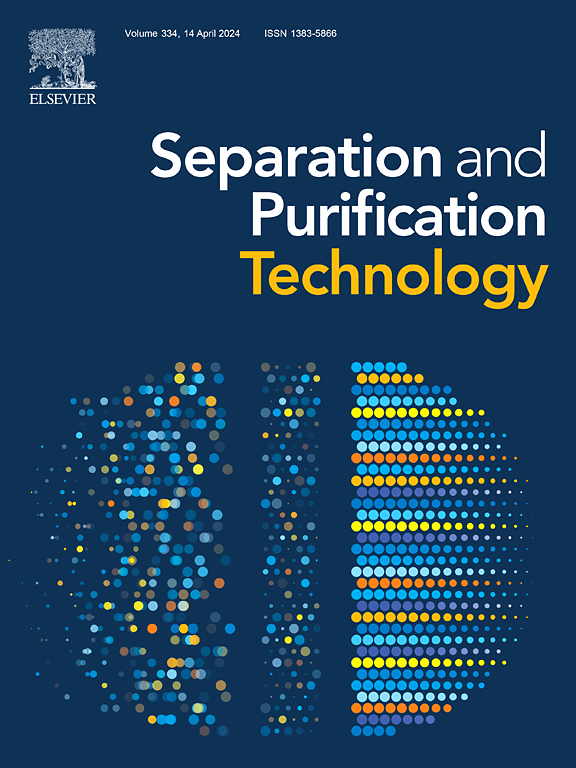A deep insight into SO2 capture performance enhancement using nanofluids composed of cyclodextrin porous liquids and ZIF-67 nanoparticles at low and high particle content
IF 8.1
1区 工程技术
Q1 ENGINEERING, CHEMICAL
引用次数: 0
Abstract
Nanofluids (NFs) have been recently used as gas separation materials and exhibited advantages in gas–liquid transfer enhancement. However, the reported work was mainly focused on the NFs with low particle content, and the absorption principal part was merely the liquid component. In this work, a kind of novel type I porous liquids (PLs) were designed through the liquefaction of cyclodextrin (CD) by chemical modification, and used as base liquids. Different sized ZIF-67 nanoparticles were uniformly dispersed into the prepared PLs to form NFs systems for SO2 capture. The synergistic effect between solid component and liquid component in NFs were fully analyzed through intensive characterization and desulfurization experiment. The results showed that the base liquids of PLs in NFs with low particle content played a chief part in SO2 capture, and the solid particles were mainly used to improve gas–liquid mass transfer. By contrast, the nanoparticles in NFs with high particle content acted as the main force for SO2 capture, and liquid component functioned as retention agent to make SO2 fully contact with solid particles. The achievements not only bring up a kind of novel SO2 capture materials of NFs, but also provide important guidance for the further exploration of combined materials for gas separation.


深入了解由环糊精多孔液体和ZIF-67纳米颗粒组成的纳米流体在低颗粒含量和高颗粒含量下对SO2捕获性能的增强
纳米流体近年来被用作气体分离材料,在增强气液传递方面表现出优势。然而,文献报道的工作主要集中在颗粒含量较低的NFs上,吸收主体仅为液体成分。本文通过环糊精(CD)的化学改性液化,设计了一种新型的I型多孔液体(PLs),并将其用作基液。不同尺寸的ZIF-67纳米颗粒均匀分散在制备的PLs中,形成了捕集SO2的NFs体系。通过深入的表征和脱硫实验,充分分析了NFs中固体组分和液体组分之间的协同作用。结果表明,颗粒含量较低的纳米颗粒中碱液对SO2的捕获起主要作用,固体颗粒主要用于改善气液传质。而颗粒含量高的纳米颗粒是捕集SO2的主力,液体组分作为截留剂,使SO2与固体颗粒充分接触。这一成果不仅提出了一种新型的NFs捕集SO2材料,而且为进一步探索气体分离复合材料提供了重要的指导。
本文章由计算机程序翻译,如有差异,请以英文原文为准。
求助全文
约1分钟内获得全文
求助全文
来源期刊

Separation and Purification Technology
工程技术-工程:化工
CiteScore
14.00
自引率
12.80%
发文量
2347
审稿时长
43 days
期刊介绍:
Separation and Purification Technology is a premier journal committed to sharing innovative methods for separation and purification in chemical and environmental engineering, encompassing both homogeneous solutions and heterogeneous mixtures. Our scope includes the separation and/or purification of liquids, vapors, and gases, as well as carbon capture and separation techniques. However, it's important to note that methods solely intended for analytical purposes are not within the scope of the journal. Additionally, disciplines such as soil science, polymer science, and metallurgy fall outside the purview of Separation and Purification Technology. Join us in advancing the field of separation and purification methods for sustainable solutions in chemical and environmental engineering.
 求助内容:
求助内容: 应助结果提醒方式:
应助结果提醒方式:


